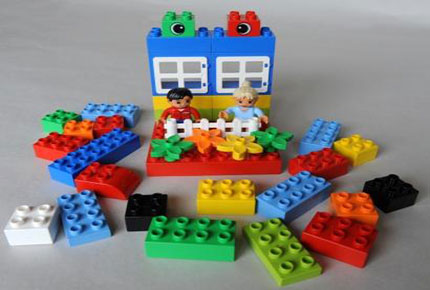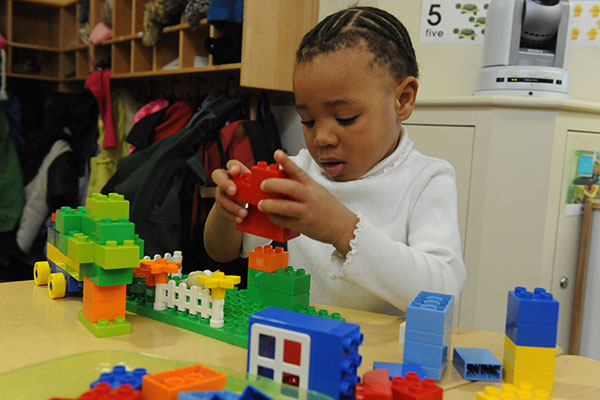2012 TIMPANI Toy Study Results
(This video has captions. You can turn them on by clicking the CC icon at the bottom of the video.)
Download a printable transcript.
Dr. Elsa Núñez, President: Hello, I’m Elsa Núñez, President of Eastern Connecticut State University. I’m excited to share with you the latest results from an annual research project at Eastern, conducted by our Center for Early Childhood Education. The TIMPANI Toy Study is carried out by both faculty and students working together to help early childhood professionals, and parents discover which toys best help children learn. I hope you find this year’s results as interesting as I do.
Dr. Jeffrey Trawick-Smith, Principal Investigator: There’s been a lot of research on children’s play and how teachers can enhance play so that it’s useful developmental and can promote learning. But one of the things that hasn’t been studied much is the effects of toys on children’s play. So we have been doing this research now for a few years. We look at how toys effect children as they play, the kinds of things that they learn, the kind of problems that they solve, their creative expression, their interactions with other children.
Methodology (1:33)
Dr. Jeffrey Trawick-Smith: We started by inviting parents and teachers to nominate toys that they believed would be beneficial to children in preschool classroom settings. The panel then selected about nine of the toys that they felt would be useful for children. They screened out some of the toys that they felt were not appropriate for children of that age group. We placed these toys in classrooms and watched what children did with them in real live play settings. We also looked at the impact of things like gender, socioeconomic status, the ethnicity of the children, to see if different toys had different effects on children from different backgrounds. We had a very talented group of student researchers who coded all of the video using a special tool that shows the value of the toy in children’s play.
Marley Koschel, Student Researcher: I did one day a week of videoing, where I would sit in a room and set of the video cameras in each of the preschool classrooms, and adjust them as needed. The other days, I did coding which is when we went and looked at the footage that had already been recorded and rated it on a series of different items.
Jenny Wolff, Student Researcher: My particular area was, not only the coding and the videotaping, but also aiding my professor in analyzing those results and gaining an understanding of what all these findings really mean; which toys aid children in different areas.
2012 Study Finding #1 (3:10)
Dr. Jeffrey Trawick-Smith: The toy that earned the highest score in this year’s study was Duplo Bricks by Lego.
Claudia Ahern, Preschool Teacher: Duplos are just a simple building toy, yet children can build elaborate structures with them. Duplos allow children to use their imagination, and they promote creativity.
Boy: This is the one that we need for the dinosaur with the eye on it.
Second Boy: And we need this one, too!
Boy: Yeah! Here’s this one also.
Dr. Jeffrey Trawick-Smith: They pose lots of problems for children to solve. So there’s lots of deep thought that goes into building. Duplo’s cause children to really study the characteristics of these toys.
Boy: Wow look how big this is!
Claudia Ahern: Children initially started to play alongside each other and they wanted to create their own structures. Then as the children built with Duplo’s, they decided that they would play cooperatively.
Boy: Alright, I got the sail!
Claudia Ahern: I saw simple building, to elaborate structures. Because we have a multi-age classroom, it was a toy that fit in perfectly.
Dr. Jeffrey Trawick-Smith: Because they didn’t suggest any one play theme, they led children to interact more, to talk about or negotiate what is was that they were going to build.
Boy: You are building the house, right?
Girl: Okay, and I’ll put the chimney on.
Dr. Jeff Trawick-Smith: So for a lot of different reasons, we feel like construction toys score very high in our studies. That’s the case here.
Amy Tyler: I really love that the Duplos could be could be a cooperative activity, or it could be an independent activity.
Boy: No, put it right here, put it right here.
Amy Tyler: Which was amazing to see three children work so well together for such a long eriod of time. It wasn’t just a construction toy. They were pretend playing. They had role laying going on.
Girl: Pretend to call me!
Boy: Hello?
Dr. Jeffrey Trawick-Smith: One of the things that important to point out, though, about Duplos compared to some of the others is they seem to maintain both child interest, and high levels of play across several days of play. Whereas other toys tended to decline in their interest value. Or they tended to decline in terms of how complex the children’s play was with them. Duplos tended to illicit very high play from children of diverse backgrounds. That’s what really kind of set them apart.
2012 Study Finding #2 (5:59)
Dr. Jeffrey Trawick-Smith: Another toy that scored very highly on our instrument were called Rainbow People. They were kind of a close runner up, I mean, they did illicit some really high quality play.
Amy Tyler: My children loved the Rainbow People. I think they were used, or intended for stacking. But again, the dramatic role playing that went into those; they created a whole big scene on a table that this person was this, this person was this...
Claudia Ahern: My gut feeling was that no one would play with the toy, and time after time I watched the children use their imagination; move the toy, they would talk with the different people. They would try to stack them on top of each other.
Amy Tyler: A lot of the times kids wouldn’t chose them. However when they did, they would use them either use them as people and play with them with each other, or they would do patterning with them, which is pretty advanced for preschoolers. There was a lot of organizing going on with them.
Implications of the Study (7:07)
Dr. Jeffrey Trawick-Smith: One of the things that was really interesting was that children’s preference for toys, that is the frequency with which they played with them, did not necessarily correlate with the benefits of those toys to children. What this suggests is that children don’t always select to play with the toys that are most useful to them in terms of development and learning. We need to give careful thought to the kinds of toys that are most useful, and not always judge which toys we’re going to choose based on how much the children love them or how often they choose to play with them.
Claudia: The bristle blocks will be here. Remind me, how many friends can play with the bristle blocks?
Class: Three!
Dr. Jeffrey Trawick-Smith: We still have questions. One has to do with the way teachers introduce toys. We noticed that there were variations from one teacher to another. It might just be that there was a little more enthusiasm, there was a longer discussion. So one thing we’d like to do in the future is look at the ways toys are introduced and what impact that might have.
Marley Koschel: The most valuable thing about doing this research, for me, is what it means to me as hoping to be a future educator. What kinds of items do I really need to focus on picking for my classroom to make an environment that will lead to their education?
Amy Tyler: I think you need to carefully look at each toy, and not just say, “Oh these are Duplos, all they’re going to do with these is build.” So when I think Duplos are for construction. They go in the block area. But to see the dramatic play and the role play with those, I think you need to clearly sit and evaluate the toys over many different domains. See if it’s okay for cooperative play or independent play, or if you can bring literacy into it, and how those toys can be used in different areas.




